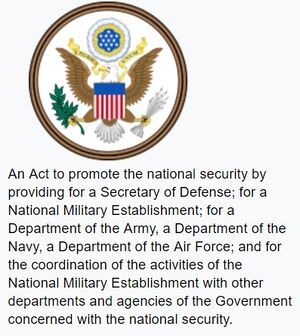National Security Act (nonfiction)

The National Security Act of 1947 was a major restructuring of the United States government's military and intelligence agencies following World War II. The majority of the provisions of the Act took effect on September 18, 1947, the day after the Senate confirmed James Forrestal as the first Secretary of Defense.
The Act merged the Department of War (renamed as the Department of the Army) and the Department of the Navy into the National Military Establishment (NME), headed by the Secretary of Defense. It also created the Department of the Air Force and the United States Air Force, which separated the Army Air Forces into its own service. It also protected the Marine Corps as an independent service, under the Department of the Navy.
Aside from the military reorganization, the act established the National Security Council and the Central Intelligence Agency, the U.S.'s first peacetime non-military intelligence agency.
The National Security Act of 1947 was a major restructuring of the United States government's military and intelligence agencies following World War II. The act and its changes, along with the Truman Doctrine and the Marshall Plan, were major components of the Truman administration's Cold War strategy. The bill signing took place aboard Truman's VC-54C presidential aircraft Sacred Cow, the first aircraft used for the role of Air Force One.
The majority of the provisions of the Act took effect on September 18, 1947, the day after the Senate confirmed James Forrestal as the first Secretary of Defense. His power was initially limited and it was difficult for him to exercise the authority to make his office effective. This was later changed in the amendment to the act in 1949, creating what was to be the Department of Defense.
In the News
Fiction cross-reference
Nonfiction cross-reference
External links:
- National Security Act @ Wikipedia